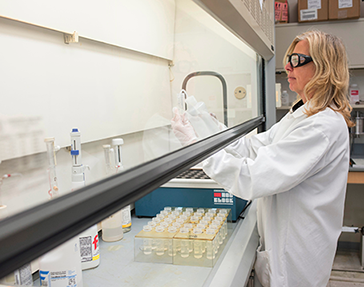
| March 2016 | |||||||||||
| Top stories | |||||||||||
| In the news | |||||||||||
| Photos | |||||||||||
| Contact us | |||||||||||
| Archive | |||||||||||
|
Lead in drinking water raises health concerns |
An increased national focus on lead in drinking water raises many questions about the health effects of lead and how exposure can be prevented.
 Lynn Aldridge, environmental laboratory analyst, prepares samples for lead analyses.
Lynn Aldridge, environmental laboratory analyst, prepares samples for lead analyses.Lead is highly toxic and can affect nearly all organs in the body. Young children, infants and fetuses are particularly vulnerable to lead. A dose of lead that would have little effect on an adult can have a significant effect on a child.
The EPA estimates that drinking water can make up 20 percent or more of a person’s total exposure to lead. Infants who consume mostly mixed formula can receive 40 to 60 percent of their exposure to lead from drinking water.
Boiling water will not get rid of lead contamination, but will concentrate the amount of lead.
What are the health effects of lead?
In children, low levels of exposure have been linked to damage to the central and peripheral nervous system, learning disabilities, shorter stature, impaired hearing, and impaired formation and function of blood cells.
Children and adults may be exposed to lead in paint, dust, soil, air and food, as well as drinking water. Adults exposed to high levels may suffer from cardiovascular effects, increased blood pressure and incidence of hypertension, decreased kidney function, and reproductive problems.
What is Iowa doing about lead poisoning?
In 2008, an Iowa law went into effect that requires children to be tested for levels of lead in their blood before entering kindergarten.
A lead screen can be performed at health care facilities. When the results indicate high levels of lead, the Hygienic Laboratory performs further testing of a blood sample as part of the Iowa Department of Public Health Lead Poisoning and Prevention program.
Many of Iowa's pre-1950 homes contain lead-based paint. Young children who live in pre-1950 homes may suffer lead poisoning when they put paint chips or exterior soil in their mouths or when they get house dust and soil on their hands and put their hands in their mouths.
Although lead poisoning can cause serious health problems--including death--most lead-poisoned children demonstrate no visible symptoms. This makes it much more important to have an effective program to prevent childhood lead poisoning.
On March 18, the Iowa Department of Public Health reported there are no known instances “where public drinking water is the major source of lead exposure for any reported child or adult with elevated blood level.”
Is anyone checking my water for lead?
If water comes from a municipal water system, the city is required by EPA to send an annual water quality report – called a Consumer Confidence Report – to customers by July 1 each year. Contact your city’s water utility to receive a copy of their latest report.
If drinking water comes from a household well or other private water supply, check with your health department, or with any nearby water utilities that use ground water, for information on contaminants of concern in your area.
IDPH recommends that water from private wells be tested at first to establish a baseline, and tested periodically thereafter based on risk factors. More information about risks and causes of lead exposure is available on the EPA website.
Private drinking water testing for lead is available for $20 through the State Hygienic Laboratory.
How does lead get in my drinking water?
Lead can enter drinking water when service pipes that contain lead corrode, especially in situations where the water has high acidity or low mineral content that corrodes pipes and fixtures. The most common problem is with brass or chrome-plated brass faucets and fixtures with lead solder. These can leach significant amounts of lead into the water, especially hot water.
A number of factors are involved when lead enters water, including:
- the chemistry of the water (acidity and alkalinity) and the types and amounts of minerals in the water,
- the amount of lead the water comes into contact with,
- the temperature of the water,
- the amount of wear in the pipes,
- how long the water stays in pipes, and
- the presence of protective scales or coatings inside the plumbing materials.
How may I reduce lead in my drinking water?
Flush pipes before drinking. The more time water has been sitting in your home's pipes, the more lead it may contain.
Anytime the water in a particular faucet has not been used for six hours or longer, "flush" your cold-water pipes by running the water until it becomes as cold as it will get. This could take as little as five to thirty seconds if there has been recent heavy water use such as showering or toilet flushing. Otherwise, it could take two minutes or longer.
For those whose water comes from a municipal water system, check with the water utility to determine if longer flushing times are needed.
Use only water from the cold water tap for drinking, cooking and especially for making baby formula. Hot water is likely to contain higher levels of lead. Run cold water until it becomes as cold as it can get.
Use water filters or treatment devices. Many water filters and water treatment devices are certified by independent organizations for effective lead reduction. Devices that are not designed to remove lead will not work. Verify the claims of manufacturers by checking with independent certifying organizations that provide lists of treatment devices they have certified.